|
Last Week Before the Spring Fish Window 
Crews continue to excavate the river channel just upstream of the former Elwha Dam, slowly lowering the river bed to its original elevation and draining the remaining reservoir. The material being excavated now is primarily rock and gravel, much of which was added to the channel after the dam failed in 1912. Contractors have another ten feet to go before they reach the original elevation of the river bed of 100 feet. Material excavated from the channel is being used to fill in the old left (looking downstream) spillway channel. Once the landscape has been rebuilt enough for equipment to reach the top of the concrete abutment, removal of that will begin. At Glines, hammering is scheduled to continue this week, following repairs to the hammer late last week. Contractors will continue lowering the dam, with the goal of reaching elevation 500 - 502 feet before May 1. Meanwhile, demolition of the Glines powerhouse continues through the middle of next week, with contractors turning their attention to removal of the penstock and surge tower after that. Once the calendar reads May 1, all in-water work will stop for two months. This clean water "fish window" is one of many measures being used to protect fish from high levels of silt and turbidity in the river during the dam removal project. Here's a link to a recent Seattle Times article that helps tell the story of sediment and turbidity management in the Elwha. Fish Update Who Were Tom and Roy? 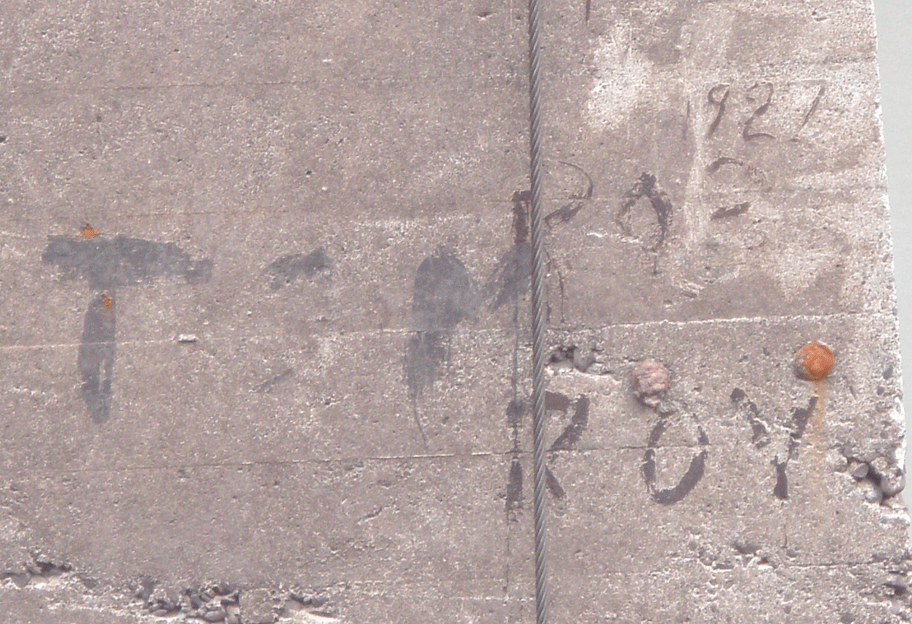
NPS Photo by Kim Kwarsick 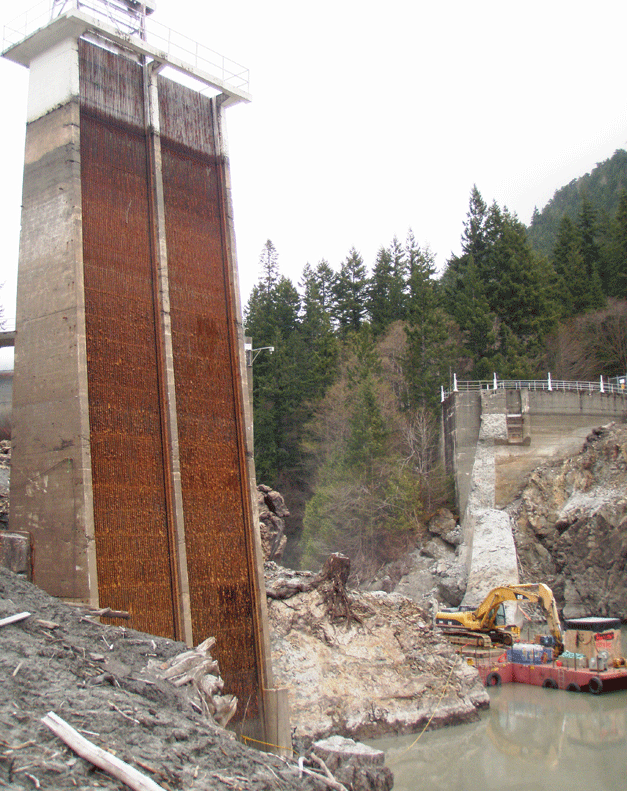
NPS Photo by Kim Kwarsick As Lake Mills has slowly drained, traces of history have emerged. On the Glines Canyon Dam intake tower, about 50 feet below the surface level of the reservoir; contractor crews discovered some decades-old graffiti. "Tom" and "Roy", both presumably part of the dam's construction crew, apparently signed their names in tar, also noting the year, 1927. 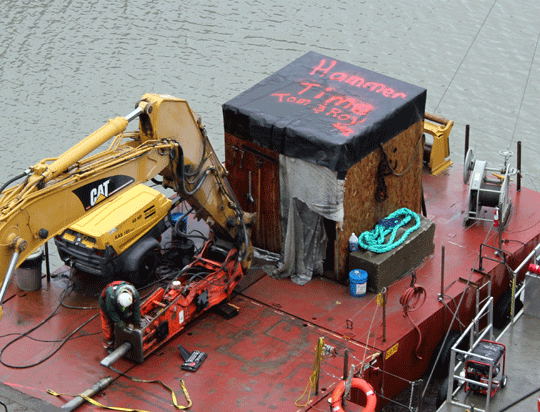
In a salute to Tom and Roy and the construction crew of the 1920s, today's crew, Andrew and Chuck (the crane and hammer operators) have added "Tom and Roy 2012" to their Hammer Time inscription on the roof of their barge-mounted job shack. Today's construction crew can frequently be heard marveling at the abilities, dedication and bravery of the men who built the dams on the Elwha. Welcome Home, Elwha! 
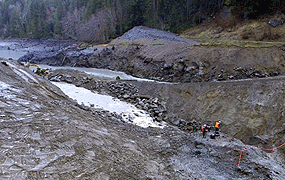
Dick Bauman USBR Early this morning, the Elwha River began flowing through its native channel for the first time in over 100 years. This final diversion and drawdown is being carefully controlled by positioning and re-positioning large boulders in the channel. It's expected to take four to five days for the river to be entirely in its new channel. During this process, flows will increase by approximately 150 cubic feet per second (cfs) as the reservoir is slowly drawn down 1.5 feet to two feet each day. The turbidity, or amount of sediment carried by the water, will also increase as the remaining Lake Aldwell reservoir is slowly drained. When the reservoir reaches elevation 134 feet around March 25, a 14-day hold will begin. As of this morning, the water level in the remaining Lake Aldwell was approximately 149 feet in elevation, 49 feet higher than the river bed at the dam site. The final drawdown will take place over at least a month and will include at least one 14-day hold. Glines Canyon Dam Over the next two weeks, they will lower the reservoir to elevation 515 feet; flows will temporarily increase by about 200 cfs. Once the reservoir reaches 515 feet (on or around April 1), another 14-day hold will begin. Workers are also scheduled to demolish the Glines Canyon powerhouse over the next two weeks. 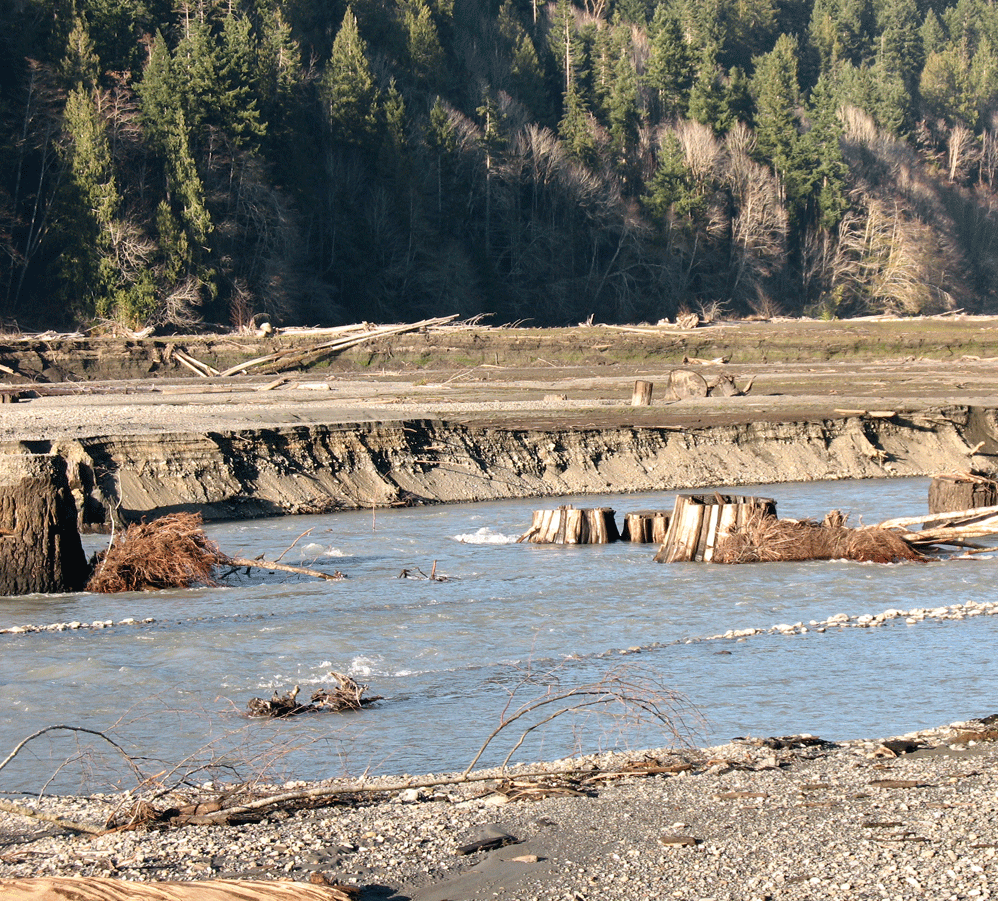
Exploring the Deltas 
A new webcam was set up this week to provide images of the upper Lake Aldwell area. Like the other Elwha cams, this one is primarily intended to provide current information on the amount of sediment transported downstream by the river, but we're happy to invite everyone to watch the landscape change as the reservoir enters its final drawdown. 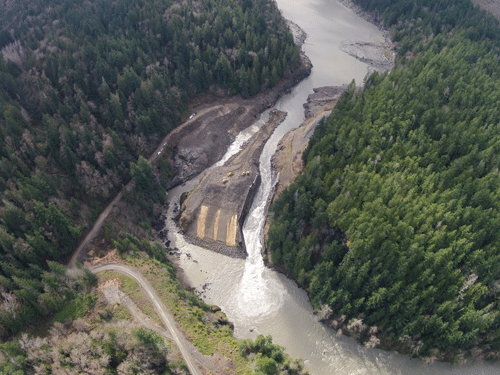
Tom Roorda 
URS Canyons Emerge As steady progress continues on dismantling the two Elwha dams, the canyons once blocked by the dams are coming into view. Elwha Dam This final diversion will take place over a number of weeks, as contractors carefully control the flow by positioning and re-positioning large boulders in the channel. During the diversion process, flows will increase by approximately 150 cubic feet per second as the river lowered 1.5 feet to two feet each day. When the reservoir reaches elevation 134, a 14-day hold will begin. This is scheduled to begin the week of March 19. The water level in the remaining Lake Aldwell is 49 feet higher than the river bed at the dam site, so the final drawdown will take place over at least a month and will include at least one 14-day hold. The river within the former Lake Aldwell remains closed to all boating. Significant safety hazards exist, including numerous submerged stumps and boulders in the river, heavy construction equipment and rapidly changing river conditions. The drained reservoir area at the south end of Lake Aldwell is open to foot travel only. The area north of the 'gooseneck' including the entire construction closed to all public entry. Read more. Contractors are also restoring the hillside terrain that was excavated during dam construction to support the dam's penstocks. Seeding of the restored slopes will continue over the coming weeks, along with removal of the concrete walls on both the left and right sides of the old dam site. Glines Canyon Dam During the hold period, contractors will begin dismantling the Glines powerhouse and gatehouse and will also chip away at the above-water sections concrete on the dam. Downward notching on the dam will start again after the 14-day hold ends on March 17. Chipping Away 
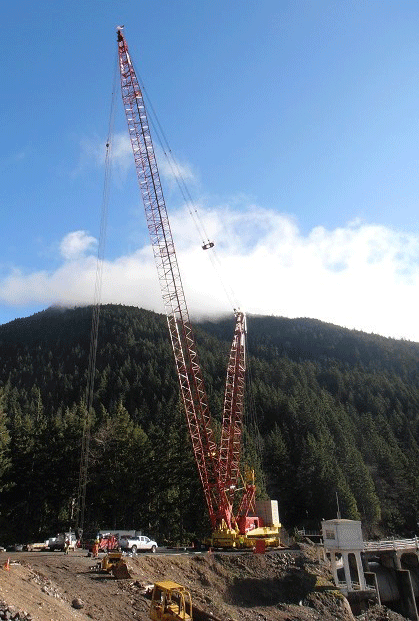
URS Glines Canyon Webcam watchers will notice changes to the barge since it was last used. Underwater pillars called spud piles were installed on the barge. The spud piles, each 30 feet long, allow the hydraulic hammer to remove the concrete 'teeth' that rise above the water between the notches, while the barge continues to rest safely against the wall of the dam. Meanwhile, the crane is "flying" a smaller hammer-fitted excavator to the right side of the dam that's high and dry and no longer accessible to the barge-mounted hammer. The platform, transport and anchoring systems have been carefully engineered to provide a safe work environment even within this dramatic high-angle setting. So far, construction crews have used both a controlled blast and the platform-mounted excavator to lower the right side of the dam; use of both of these techniques will likely continue in coming weeks. Elwha Dam Contractor crews also began final grading and placing rip-rap along the river at the old powerhouse site. Watch what's happening on the webcams! 
URS Changing Landscapes 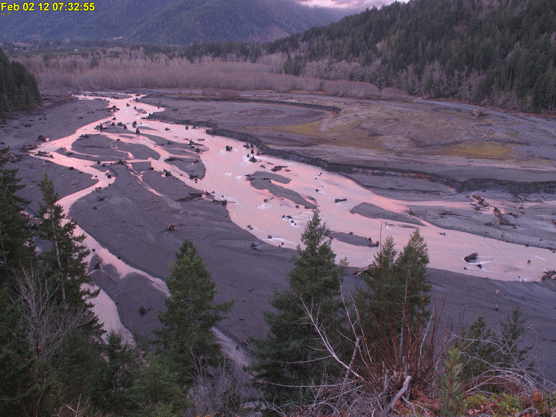
NPS 
URS Last week's controlled blast at Glines Canyon Dam succeeded in removing much of the concrete from the right side (looking downstream) of the dam. Although a second blast had been considered (and may be used in the future) the contractor will use a hydraulic hammer to remove the next chunks of concrete from the right side. Beginning later this week, the large onsite crane will transport a work deck and excavator fitted with a hydraulic hammer to the dam's right side. (Both the excavator and hammer will be considerably smaller than the barge-mounted versions that have been working on the rest of the dam.) The deck will be firmly tied in to the dam, and the crane, as an equipment operator chips away the remaining right side. Find out why the right side needs a different approach. Check these links for videos - taken from remote-operated cameras - of last week's controlled blast. (video one by ONP Partner Wings Over Watersheds & Fox-Wilmar, video two by ONP Volunteer John Gussman) Downward notching of Glines Canyon Dam is on a 14-day hold (link to last week.) Improvements to the barge are underway. Notching is scheduled to begin again on February 9, and contractors will continue that over the coming week as they lower the reservoir to elevation 530. Flows are anticipated to temporarily increase by about 200 cubic feet per second (cfs) beginning on or around February 9. Elwha Dam Keep in touch with Elwha River Restoration on Facebook! 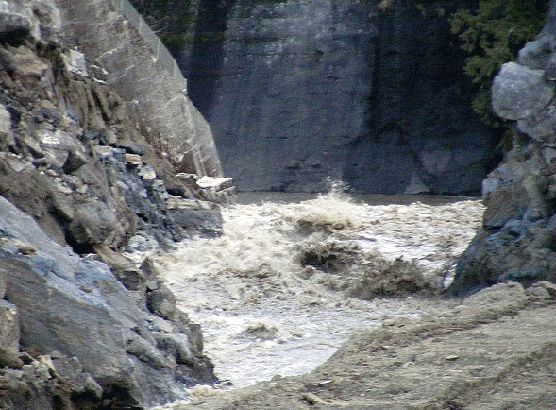
URS 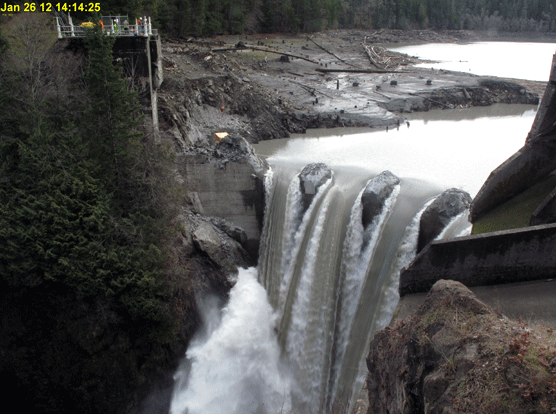
There's more info about preparations for this blast (and other activities) in the blog post below, posted earlier today. 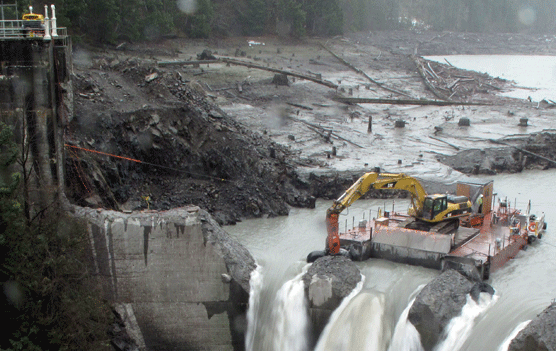
Controlled Blast Planned at Glines Despite the recent snow, heavy rain and high winds, contractor Barnard Construction, Inc. and their subcontractors have continued working and both removal projects are on schedule. Watch what's happening on the webcams! Glines Canyon Dam The following series of photos gives some insight into what the drilling crew has been working on this week. Over 50 holes have been drilled in the top six feet of the concrete. In the next step, the holes will be filled with explosives and detonated. The Whiskey Bend Road is currently closed to vehicles because of snow, and the area will be entirely closed to entry during all periods of blasting. 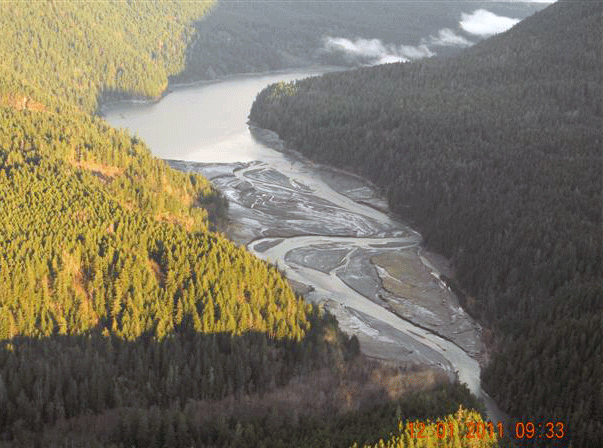
USBR An additional blast is scheduled for the coming days, to remove another six to eight-foot section of the right side of the dam. As this above-water work is happening on the right portion of the dam, downward notching of the dam (using the hydraulic hammer) will continue to elevation 535 feet at the base of the notches during the rest of this week; flows will temporarily increase by about 200 cubic feet per second (cfs). Once that level is reached by the end of this week, downward notching will be put on a 14-day hold. The hold period is designed to allow the river two full weeks to erode back and forth across the Lake Mills delta, transporting fine sediments downstream. During the hold period, Barnard crews will install two underwater pillars called "spud piles" on the front corners of the barge. The piles will consist of two 24" diameter steel pipes, each of them 30 feet long, that will extend vertically underwater to brace the barge against the face of the dam. The spud piles will provide a safe means of securing the barge, while allowing more water to flow over the crest of the dam. Currently, the barge is secured against the concrete columns that extend above the water between the notches. These will be removed once the spud piles are installed on the barge, making the barge appear to be precariously perched at the top of the dam. Webcam watchers may rest assured however, knowing that it is safely held in place by the engineered underwater spud piles. Elwha Dam The river has been flowing through the right channel since early this week and crews have been hammering away to lower the bed of the left channel to 140 feet. Once they reach that elevation by the end of this week, they will shift the river back into the left channel. The reservoir will be drawn down to about 145 feet and flows will temporarily increase by approximately 150 cfs. A 14-day hold at Elwha Dam will begin on January 30, allowing the river to work its erosive force on the Lake Aldwell delta, washing accumulated sediments downstream where they will replenish the shoreline and beaches. Once the river returns to the left channel later this week, it will remain there for about three to five weeks. During that time, contractor crews will excavate the remaining gravity dam, removing the concrete all the way down to the original river bed. Large amounts of fill material just upstream of the gravity dam still need to be excavated, and additional work will continue in coming months as crews remove other material and restore the site. Note: In river speak, "right" and "left" always refer to what you see when looking downstream. 

January 12, 2012 The recent dry weather and low river flows have made the work easier as contractors chip away at removing the two dams. Approximately one half of the Elwha Dam's original height has been removed so far, and about ten percent of the total volume of the concrete of Glines Canyon Dam. Over the next two, contractors will demolish the remaining downstream wall of the Elwha Dam powerhouse (and webcam contractors will re-adjust the Elwha webcam on their next maintenance visit. Thanks to all of you who noticed the changed angle on the webcam image!) The river will be diverted once again to the right channel early during the week of January 23, and reservoir will be drawn down to about 148, just over half way from its starting point. Flows will increase by about 150 cubic feet per second (cfs.) By the end of that week, the river is scheduled to move back to the the left channel, with another drawdown to begin then. Flows will once again increase by about 150 cfs and the reservoir will drop to about 144 feet. This back-and-forth movement of the river's flow allows the contractor to drop the level of the two channels in small increments, providing for slow and deliberate lowering of the reservoir. The slow drawdown is one of many strategies that are being used to manage the movement of sediments that have accumulated at the bottom of the two reservoirs. At Glines Canyon Dam, notching will continue and flows will increase by about 200 cfs next week, as the reservoir level drops to about 545 feet, approximately 55 feet below its original crest. Check out our 'Elwha River Restoration' page on Facebook -- we've just added a couple new photo albums of recent work at both Glines and Elwha. 
A New Year on the Elwha River Demolition of the two Elwha River dams progressed over the holiday break, and continues despite this week's heavy rains and high flows. Elwha Dam This back-and-forth movement of the river's flow allows the contractor to drop the level of the two channels in small increments, providing for slow and deliberate lowering of the reservoir. The slow drawdown is one of many strategies that are being used to manage the movement of sediments that have accumulated at the bottom of the two reservoirs. 
Crews have removed about one-half of the dam's overall height. (The tallest part of the Elwha Dam, which blocks the river's natural channel, can be identified by the big concrete stair steps on the left side of this photo.) You can watch the river's travels over the past few weeks by selecting one of the Elwha Dam slide shows at the Elwha River Restoration Project webcam page. Once you're in the slide show, select "list" from the menu and pick December 20, 2011 and you see the progression in just a few minutes. Coming Up at Elwha Dam Glines Canyon Dam Entries from 2011 can be found in the archives here. |
Last updated: June 7, 2024
